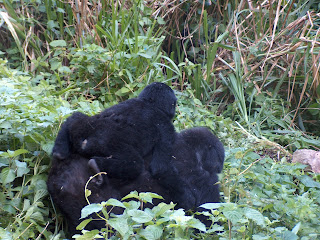
2010 is proving to be an exciting year indeed! There has never been a better time to celebrate the International Year of Biodiversity with a new species of primate being discovered! Fauna & Flora International was part of a team of primatologists that recently discovered a completely new species of monkey Rhinopithecus strykeri in Northern Myanmar (formerly Burma). Local hunters reported the presence of a monkey which did not match any description of species previously identified in the area. Sadly this latest addition to the snub-nosed family is already threatened. Hunting pressure is rising thanks to loggers moving into the previously isolated distribution area of this species. Based on direct observations and evidence from local people, the team of researchers have estimated the total population of R.strykeri to be 260-330 individuals, making them a threatened species when they’ve only just been discovered. All species of snub-nosed monkey are considered critically endangered, including the striking blue-faced R.roxellana or golden snub-nosed monkey. With the new snub-nosed monkey Myanmar has now 15 species of primates, which underlines the importance of Myanmar for biodiversity conservation.

Photo credit: A digital reconstruction of the Burmese Snub-nosed monkey by Dr Thomas Geissmann
Hunting and habitat destruction are the key threats facing all primate species including the great apes. Just over 700 mountain gorillas remain in the world today. Two isolated populations survive, one in the Bwindi Impenetrable National Park, south-western Uganda, and the other on the forested slopes of the Virunga volcanoes, straddling the borders of the Democratic Republic of Congo (DRC), Rwanda and Uganda. The forest has been recognised as one of the most biologically diverse areas on earth by the United Nations Educational, Scientific and Cultural Organisation (UNESCO) as a World Heritage Site.


In 2003 I visited the magnificent Bwindi Impenetrable Forrest, home to half the world’s population of critically endangered Mountain Gorillas Gorilla beringei beringei. It was an unbelievable experience, one which I will never forget. We trekked for over two hours through the humidity of the forest and up steep inclines until one of the conservation guards held up his hand and told us to be very quiet as he had detected fresh signs of gorilla activity. Within minutes we were surrounded by them. There were mothers and babies all around us, feeding, playing and before we knew it the silver back roared past us in an attempt to show us who’s territory we were on, before sitting down and beating his chest wildly with satisfaction.

My heart was beating so fast I thought I was going to faint. We could only spend an hour with them and then we had to leave to prevent any cross contamination of disease, so I snapped as many quick photographs as I could get whilst hanging onto a branch to stop myself slipping down the ravine, hence the blurred photos, and then spent the rest of the time just watching them and being among them for I knew there and then that I may never get the opportunity again to walk and be amongst wild free Gorilla’s.

The only reason there still are this tiny number of wild Gorilla’s still living and roaming the forests free today is down to the countless hours of dedication and commitment of the national park staff who patrol these forests on a daily basis to protect the Gorilla’s from hunters and poaching. But these conservation efforts have cost many lives, both human and Gorilla, for life is cheap in Africa and a Gorilla to a man and his starving family is just another meal to survive yet another tough day in Africa.
Lets hope the next generation of conservationists and their efforts can help build a stronger future for all the amazing species which share our beautiful planet with us.

.jpg)
.jpg)
Comments are welcome and can be sent to ukulalana@gmail.com if you are not a google mail user. Have a brilliant week.
Regards
Nic x

I like ya blogg!! Very good :-)))
ReplyDeletelooks like a fantastic trip
ReplyDelete